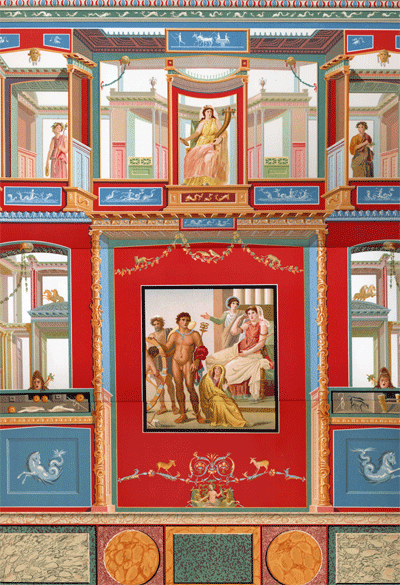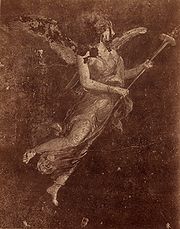
House of the Vettii
Encyclopedia

Pompeii
The city of Pompeii is a partially buried Roman town-city near modern Naples in the Italian region of Campania, in the territory of the comune of Pompei. Along with Herculaneum, Pompeii was destroyed and completely buried during a long catastrophic eruption of the volcano Mount Vesuvius spanning...
one of the most famous of the luxurious residences (domus
Domus
In ancient Rome, the domus was the type of house occupied by the upper classes and some wealthy freedmen during the Republican and Imperial eras. They could be found in almost all the major cities throughout the Roman territories...
) is the so-called House of the Vettii, preserved like the rest of the Roman city by the eruption of Vesuvius in 79 AD. The house is named for its owners, two successful freedmen
Freedman
A freedman is a former slave who has been released from slavery, usually by legal means. Historically, slaves became freedmen either by manumission or emancipation ....
: Aulus Vettius Conviva, an Augustalis
Sodales Augustales
The Sodales Augustales or Sacerdotes Augustales, or simply Augustales, were an order of Roman priests instituted by Tiberius to attend to the maintenance of the cult of Augustus and the Iulii....
, and Aulus Vettius Restitutus. Its careful excavation has preserved almost all of the wall fresco
Fresco
Fresco is any of several related mural painting types, executed on plaster on walls or ceilings. The word fresco comes from the Greek word affresca which derives from the Latin word for "fresh". Frescoes first developed in the ancient world and continued to be popular through the Renaissance...
s, which were completed following the earthquake of 62 AD
62 Pompeii earthquake
The 62 Pompeii earthquake occurred on 5 February. It had an estimated magnitude of between 5 and 6 and a maximum intensity of XI or X on the Mercalli intensity scale. The towns of Pompeii and Herculaneum were severely damaged. The earthquake may have been a precursor to the eruption of Mount...
, in the manner art historians term the "Pompeiian Fourth Style."
Plan
_04.jpg)
Atrium (architecture)
In modern architecture, an atrium is a large open space, often several stories high and having a glazed roof and/or large windows, often situated within a larger multistory building and often located immediately beyond the main entrance doors...
into which a visitor would pass, coming from a small dark vestibule that led from the street entrance, and beyond— perpendicular to the entrance axis— a daylit peristyle
Peristyle
In Hellenistic Greek and Roman architecture a peristyle is a columned porch or open colonnade in a building surrounding a court that may contain an internal garden. Tetrastoon is another name for this feature...
of fluted Doric columns
Doric order
The Doric order was one of the three orders or organizational systems of ancient Greek or classical architecture; the other two canonical orders were the Ionic and the Corinthian.-History:...
surrounded on all sides by a richly frescoed portico
Portico
A portico is a porch leading to the entrance of a building, or extended as a colonnade, with a roof structure over a walkway, supported by columns or enclosed by walls...
, with the more formal spaces opening onto it. Servants' quarters are to one side off the atrium, ranged round a small atrium of their own. The major fresco decorations enliven the peristyle and its living spaces (oeci
Oecus
Oecus, the Latinized form of Gr. oikos, house, used by Vitruvius for the principal hall or salon in a Roman house, which was used occasionally as a triclinium for banquets....
) and the triclinium
Triclinium
A triclinium is a formal dining room in a Roman building. The word is adopted from the Greek τρικλίνιον, triklinion, from τρι-, tri-, "three", and κλίνη, klinē, a sort of "couch" or rather chaise longue...
or dining hall.
In the entrance foyer the prosperous and almost life-size image of Priapus
Priapus
In Greek mythology, Priapus or Priapos , was a minor rustic fertility god, protector of livestock, fruit plants, gardens and male genitalia. Priapus is marked by his absurdly oversized, permanent erection, which gave rise to the medical term priapism...
weighs his erection which protrudes from beneath his tunic against a bag of overflowing with coins in a set of scales that he holds. Throughout the house, the decor is unified by the black backgrounds of its large frescoed panels, in "Pompeiian" red and yellow framing, with fanciful architectural surrounds. Also throughout the house were images of hermaphrodites with the intention to ward off the Evil Eye of envy from those who entered the home. In one oecus, a frieze at sitting height, in monochrome against black grounds, show putti and infant psyches
Psyche (psychology)
The word psyche has a long history of use in psychology and philosophy, dating back to ancient times, and has been one of the fundamental concepts for understanding human nature from a scientific point of view. The English word soul is sometimes used synonymously, especially in older...
engaged in various trades, wine-making, goldsmithing, perfume-pressing and similar occupations. The most richly-decorated room is a virtual picture gallery, with trompe l'oeil
Trompe l'oeil
Trompe-l'œil, which can also be spelled without the hyphen in English as trompe l'oeil, is an art technique involving extremely realistic imagery in order to create the optical illusion that the depicted objects appear in three dimensions.-History in painting:Although the phrase has its origin in...
views of architecture.

Paris (mythology)
Paris , the son of Priam, king of Troy, appears in a number of Greek legends. Probably the best-known was his elopement with Helen, queen of Sparta, this being one of the immediate causes of the Trojan War...
carrying a lamb and three bronzes of cupids, each holding a goose and a bunch of grapes. The statues were connected to lead piping and spouted water. There are 14 jets of water.
Further reading
- R. Etienne, Pompeii. The Day a City Died (London 1986; 3rd ed. 1994)
- R. Laurence, Roman Pompeii: Space and Society (London, 1994)
- A. Wallace-Hadrill, Houses and Society in Pompeii and Herculaneum (Princeton, 1994)

